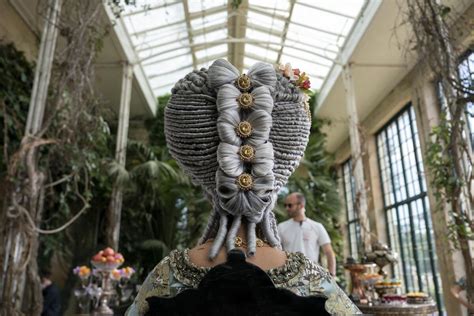Introduction
Queen Charlotte of Mecklenburg-Strelitz, consort of King George III, was known for her elaborate and iconic wigs. These wigs, crafted from human hair and adorned with ribbons, lace, and jewels, became a symbol of her status and fashion sense. Over the centuries, Queen Charlotte’s wigs have inspired countless hairstyles and continue to be a source of fascination and inspiration today.

History of Queen Charlotte’s Wigs
Queen Charlotte, born in 1744, became queen consort in 1761 at the age of 17. During the 18th century, wigs were a common part of royal attire, and Charlotte’s wigs were particularly renowned for their size and grandeur.
Size and Scale: Charlotte’s wigs were often enormous, measuring up to two feet in height. The base of the wig was crafted from horsehair or wire, and the hair itself was typically human hair from local villages across England or Germany. It took skilled hairdressers hours to create these elaborate masterpieces.
Decoration and Accessories: Charlotte’s wigs were adorned with a variety of embellishments, including ribbons, lace, flowers, feathers, and jewels. These decorations served both practical and aesthetic purposes, securing the wig in place and adding to its overall grandeur.
Impact on Fashion and Culture
Queen Charlotte’s wigs had a profound impact on fashion and culture of the time:
Royal Style Icon: Charlotte’s wigs became a symbol of her status and fashion sense, and inspired countless imitators among the upper classes. Women across Europe sought to emulate her hairstyle, creating a demand for elaborate wigs and hairpieces.
Economic Impact: The production of wigs was a major industry in the 18th century, and Charlotte’s wigs helped to stimulate this trade. Wigmakers across England and Europe benefited from the demand for her iconic hairpieces.
Modern Interpretations
In recent years, Queen Charlotte’s wigs have enjoyed a resurgence in popularity:
Historical Reenactors: History enthusiasts and reenactors often use wigs to recreate the hairstyles of the past. Charlotte’s wigs are a popular choice for those portraying the queen or other members of the upper classes.
Fashion and Hair Stylists: Modern fashion and hair stylists draw inspiration from Charlotte’s wigs, creating contemporary hairstyles that incorporate elements of her iconic look.
Pop Culture: Queen Charlotte’s wigs have been featured in numerous films, television shows, and other media, further solidifying their status as cultural icons.
How to Wear a Queen Charlotte Wig
For those seeking to emulate Queen Charlotte’s iconic hairstyle, it is important to consider the following:
Wig Construction: Queen Charlotte’s wigs were typically made from real human hair on a base of wire or horsehair. Modern wigs may use synthetic hair or a combination of materials for durability and cost-effectiveness.
Size and Shape: Choose a wig that is proportionate to your head size and face shape. If in doubt, opt for a slightly smaller wig and adjust it accordingly.
Embellishments: Accessorize your wig with ribbons, lace, flowers, or other embellishments to create a truly regal look.
Queen Charlotte Wig Styles
Queen Charlotte’s wigs came in a variety of styles:
The “Fontange”: A towering wig with multiple tiers of curls, named after the Duchess of Fontanges, a mistress of King Louis XIV of France.
The “Beehive”: A wig with a tall, rounded crown, similar to the shape of a beehive.
The “Pompadour”: A wig with a high, puffed crown, named after the mistress of King Louis XV of France, Madame de Pompadour.
Table 1: Timeline of Queen Charlotte’s Wigs
| Year | Key Event |
|---|---|
| 1761 | Queen Charlotte becomes queen consort to King George III |
| 1765 | First recorded commission for a wig from the royal wigmaker, Thomas Brereton |
| 1770 | Charlotte commissions a wig from the Parisian wigmaker, Leonard Autié |
| 1780 | Charlotte’s wigs reach their peak of size and elaboration |
| 1790 | Charlotte begins to wear smaller, more demure wigs |
Table 2: Types of Hair Used in Queen Charlotte’s Wigs
| Hair Type | Source |
|---|---|
| Human Hair | Local villages across England or Germany |
| Horsehair | Base of the wig |
| Wool | Base of the wig (less common) |
| Synthetic Hair | Modern wigs |
Table 3: Decorations and Accessories Used on Queen Charlotte’s Wigs
| Decoration | Purpose |
|---|---|
| Ribbons | Secure the wig in place, add visual interest |
| Lace | Adorn the wig, add texture |
| Flowers | Add color and fragrance |
| Feathers | Add height and drama |
| Jewels | Indicate status and wealth |
Table 4: Historical and Modern Uses of Queen Charlotte Wigs
| Use | Example |
|---|---|
| Historical Reenactment | Portraying Queen Charlotte or other historical figures |
| Fashion and Hair Styling | Creating contemporary hairstyles inspired by Charlotte’s wigs |
| Pop Culture | Depicting Queen Charlotte in films and television shows |
| Educational Displays | Showcasing the fashion and culture of the 18th century |
Conclusion
Queen Charlotte’s wigs remain a testament to her status, fashion sense, and enduring influence. These elaborate hairpieces have inspired countless hairstyles and cultural trends over the centuries and continue to captivate the imagination today. Whether recreating historical hairstyles or finding inspiration for modern fashion, Queen Charlotte’s wigs offer a glimpse into the grandeur and opulence of the royal court.
